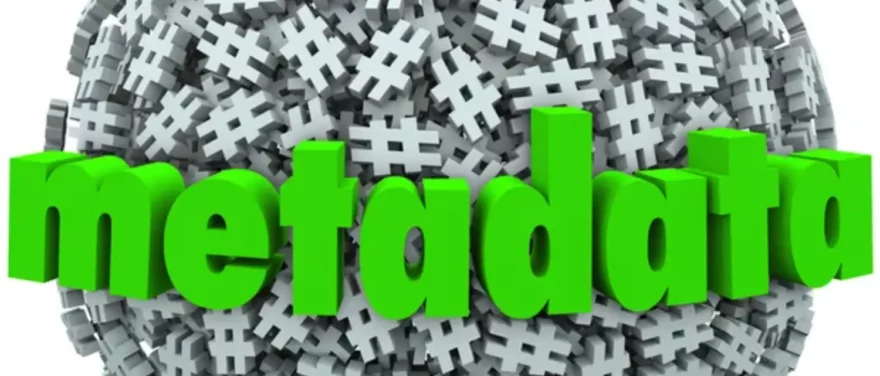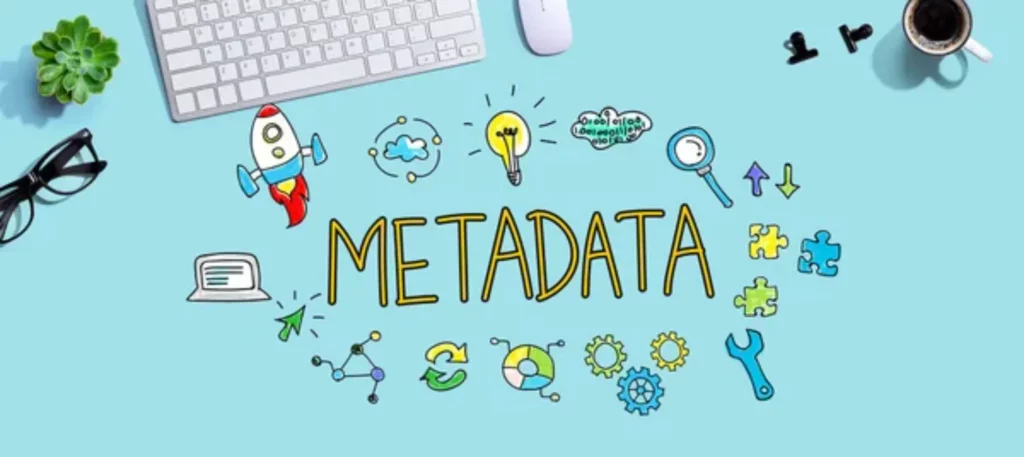
Every day, without even realising it, we read and send a myriad of metadata through our electronic devices. But what exactly are they? What are the different types? How is this information used? With this Metadata guide, you’ll find out everything you need to know, even how to hide it, in case you want to protect your digital privacy.
It provides a lot of personal information to third parties, such as your IP address, the volume of data transmitted in downloads and uploads, and even your connection details. But it isn’t just about your internet connection. It’s found in pretty much any digital file you create or browse, even without realising it. So, let’s see immediately what it is and how it works, what types there are, and how to hide it to protect your privacy.
What is Metadata?
To define metadata, we’ll use one of the most common and most likely practical definitions: It is data that describes other data. This means that metadata provides data and information: if we’re talking about IT documents, it helps to describe and contextualise them, clarifying their function and, if necessary, their relationships with other documents. Here are some different ways of defining it.
-Metadata is information about other data. To simplify, it is information that summarises the data contained in web pages, files, documents, and more. Think of it as describing the “data” of a file, which then makes it easier to find and work with such instances.
-Metadata is useful for cataloguing and ordering “libraries” of data. They help improve the accuracy and efficiency of many IT processes around the world. They are found everywhere and are essential for different industries, such as eCommerce, computer systems, video and music streaming services, social media, and websites.
-Any data that helps identify, describe, and indicate the location of networked electronic resources or structured, coded data that describes the characteristics of information-bearing entities to help identify, discover, evaluate, and manage the entities described.
-Any formal plan or system for describing resources applied to any kind of object, whether digital or non-digital.
-Data describing the characteristics of a source, diagnosing its relationships, and supporting its discovery and practical use. It is found in an electronic environment.

-Metadata usually consists of a set of data elements, where each element describes a characteristic of the resource.
– Structured information is used to find, access, use and manage information resources in a digital environment mainly, and the metadata system consists of a set of predetermined elements that contain information about a source.
– Data organised in an entity, or associated with an entity, describing this entity and assisting in its retrieval, and whatever the definition, the idea of metadata is structured information that represents the characteristics of information sources for the purposes of identification, discovery, management, and it is information about information, i.e. information to define graphical relationships, classification, and description and it is organised in a way that allows conducting a search through the pages of the global network of the information correctly and effectively.
Metadata gives basic information about a resource that a machine can understand and therefore interpret and search for. Metadata is a mean of encoding information (CODING) within the framework of specific rules that are created using meta tags on internet pages and search engines to characterise those pages. The page encodings do not appear to the reader when reading that page, which is why they are called background data.
Types of Metadata
It can be divided into three types:
Descriptive Metadata
This is more like descriptive indexing and its procedures, through which it is possible to identify and understand what has been obtained from the contents of the sites and sources of digital information, where the address is given to the digital information, which is responsible for finding and creating it.
An author, for example (as a person) or an entity, defines the subject or function keywords, the language used, the date of preparation of the material and its conversion into digital form, and the available format of the material (format) although it is a digital material.
There are a number of specifications that must be mentioned to help researchers and beneficiaries deal with it, for example, the software that must be used and its availability, the type and specifications of the computers used, coverage includes the number of pages or volumes of the paper original converted into digital form and the years covered by this process, especially for journal articles.
Structured Metadata
This type includes an integrated description of the materials and sources of information that have been converted from their traditional form to the new computerized format. The best example is the paper pages (which represent the original book) and then the number of pages that changed the paper form to the digital form, known as images, because the transformation will inevitably vary from page numbers in paper format to digital format.
As well as the number of chapters, indexes and references that were present in the original paper, as well as this type, includes numbers and lists of figures and graphics if the book contains them, and this type helps the researcher to review these matters during the process of searching for the text and the required digital information.
Administrative Metadata
Administrative data relates to the method of availability, management and preservation of digital resources and can provide information about the size of files and how to open and use them. RIGHTS Management after digital libraries has become available to researchers and beneficiaries to use the property and collections of the library, in addition to the possibility of accessing and using digital information sources that the library does not own and is not part of its contents. Still, instead, we access it through information services on the direct line of other libraries and institutions.

Another point of view divides it into two distinct categories: structured and oriented.
Structural Metadata
Used to describe the composition of computer systems such as tables, columns, and indexes.
Directed/Oriented Metadata
They are used to help get specific things. We usually express this type of metadata as a string of natural language keywords.
Relational Database Metadata
Every relational database system has its own mechanisms and mechanisms for storing metadata. The following examples contain relational database metadata:
Tables for all the tables in the database, their names, sizes, and the number of rows in each table. Tables for the columns in each database, in which these tables are used, and the type of data stored within each column. In database concepts, this string of metadata is known as a catalogue. SQL benchmarks define a standardised method for accessing the index called an information schema, but not all databases implement this, as they implement some other aspect of SQL benchmarks.
Data Warehouse Metadata
Metadata storage data is sometimes separated in two ways:
1- A back room for metadata used to extract, transform, and package works to obtain OLTP data within a data store.
2- A metadata front room used for screen addressing and generating reports.
Source Systems Metadata
Source properties, such as archive stores and graphs.
– Ancillary resource information includes property description, updates, legal barriers, and entry routes.
– Operations related to information, such as schedule of working times and laconic symbols.
Data Classification Metadata
– Data acquisition information, such as sending schedules of stops and data results.
– Control of scales, such as defining scales.
-Changing the structure of information in order to develop data.
-Review and document work records such as written records and data conversion records.
DBMS Metadata
-DBMS tables of contents.
– Data processing.
– MICHAEL BRACKET defines (Data Sources) metadata as any data about any organisation’s data sources. Aducnne Tannebaun defines it as (the detailed description of real-time data, the form and characteristics of real-time data, meaning views and values dependant on the role of the recipient. These definitions are among its definition characteristics)—data on data.
Business Intelligence Metadata
Business information is the process of analysing vast amounts of overlapping data, usually stored in large databases such as data warehouses, and it is related to job performance and helping the contracting business user to make good decisions. Business information metadata explains how to query data and how to filter and analyse it with information software tools. Businesses like OLAP reporting tools.
OLAP System Metadata
It is a structural description of scales, cubes, hierarchies, and levels.
Reporting Metadata
A structural description of reports, graphs, queries, data strings, data filtering, and variables. Business information metadata can be used to understand how comprehensive financial reports directed to Wallstreet are calculated and how income, expense, and interest are calculated from sales and individual transactions stored within the data store. It is necessary to understand business information metadata to solve complex problems such as compatibility with comprehensive control metrics such as SOX or Basel II software.
Information Technology Metadata
David Marco, another theorist, defines metadata as all physical data and knowledge from within and outside an organisation, including information about physical data, technical and financial processes, laws and data constraints, as well as the structure or composition of the data used by a company.
Some other theorists also added web services, systems and interfaces. Note that such definitions greatly expand the field of metadata to include more or all of the data required by information management systems. In this sense, the idea of metadata has significant overlaps with the concept of ITIL as well as with the fields such as contracting to engineer and manage information technology files, and since metadata is a comprehensive meaning, focused attempts to saturate it need to focus on its solid and extensive assets. Contracting assets can represent a small percentage of the information technology documents file.
IT Metadata Management products
-First-generation data dictionary storage tools are only those that contain a specific DBMS, such as the DBMS’s built-in data dictionary and Adabas predictions.
– The second generation is the ASG data management product that contains several types of files as well as several types of DBMS.
-Third-generation stored products became popular in the early 1990s with the widespread use of RDBMS engines such as IBM’s DB2.

File System Metadata
Almost all file systems make it poorly controlled over these files. Some of these systems keep metadata in directed entries, others in a specialised structure or even within a filename. Metadata can vary from simple time stamps to fragments and methods to other special-purpose information used. In application to icons and text comments, for more complex metadata, it became necessary to search for files based on their contents.
UNIX search is a prime example, although it is unsuccessful when scanning hundreds of thousands of files on a modern computer system, the current version of the APPLE computer. It has the ability to index and search file metadata through a feature known as SPOTLIGHT Microsoft has been working on developing similar functionality in the WINFS file system, although the project has been cancelled. LINUOC uses an upgraded file property to implement file metadata.
Image Metadata
Examples of image files that contain metadata are the Interchangeable Image File Formats (EXIF) and Posted Image File Formats (TIFF).
Inserting image metadata into TIFF or EXIF files is a way to get additional data about images. Image metadata obtained through footers, an image footer with subjects and other descriptive sentences, help internet users to search for images easily instead of searching through extensive folders of images.
Flickr is a prominent example of an image footer service through which users upload images and then describe their contents.
Digital photography is increasingly using its appendices. Live camera capture files can be used by several applications, such as Adobe Bridge or Apple computers Aperture applications, to manipulate camera metadata for post-development. Users can also append images for organisational purposes using Adobe’s Extensible Metadata application language platform (XMP).
Programme Metadata
Metadata is used incidentally to describe data used in engineering programmes that are more innovative. Most sample files contain what is appropriate to name metadata that defines some behavioural properties. Still, it is hard, if not impossible, to accurately distinguish between programme metadata and computer architecture programmes that are stored.
Within a Java application, files contain metadata used by the Java programmer and the Java default device in order to dynamically join partitions J25E5.0 – Java contains a metadata service that allows adding additional comments. Within an MS-DOS application, COM files do not contain metadata, while PEWINDOWS and EXE files do. Metadata can contain the company that issued the programme, the date the programme was created, and the version number.
Document Metadata
It is stored with document files in most document-creation programmes, including Microsoft Word and other Microsoft office products. These can contain the name of the person who edited the file, the number of times the file was printed, and the number of times the file was reviewed. Stored materials, stored text, and comments about the document are also generally considered a type of metadata.
Meta Models
The models are known as Meta models, and the model must be compatible with the metadata model, and according to the MDA guide, the metamodel is a model, and each model corresponds to a specific metamodel.
Strange Metadata
Since it is data, it is possible to get metadata about metadata. The metadata contained within the content is called embedded metadata. The data store holds the metadata that is specific to the data.
Digital Library Metadata
There are three categories that are usually used to describe things within a digital library.
1- Descriptive metadata: information that describes the intellectual content of things, such as MARC cataloguing records. This is mainly used for bibliographic purposes and for searching and retrieving information.
2- Structural metadata: It is the information that links each element to the other to form units Boolean (e.g., information that relates images of individual pages within a book with additional pages to make up that book).
3- Administrative metadata: It includes information that is used to control the elements or control access to them. This may include information about how to scan this item, how it is stored, copyright and licencing information, and information about long-term preservation.
Geospatial Metadata
It describes geographical elements (such as data series, maps, features, or documents that include geographical components) dating back to the year 1994 AD.

Metadata Functions
It has many tasks, functions, and benefits of electronic information, including:
1- Facilitating access to automated information, identifying sources, and distinguishing between similar sources.
2- It helps to interpret the information.
3- It allows the exchange of records between several systems, regardless of the type of system or system the program used.
4- Organizing information, especially in the web environment, accurately, with a framework that defines each document element.
5- It provides accurate information on the origin and condition of the source, coverage area and period trading as well as related sources.
6- Limit linguistic problems, including, for example, words that contain more meaning or contain ambiguity in meaning.
7- It helps search engines index the site more accurately rather than relying on it for a full-text search of the site.
8- Providing descriptive and objective data for documents in a way that enables computer systems to read it and process it in search and retrieval operations. It is used on the technological side.
The Importance of Metadata and its Benefits
The massive amount of data flowing through the internet is a real problem how to deal with it. The world today is shifting from an economic system supported by information to an information system that folds the economy inside it, and those in charge of preparing internet sites are not documented initially.
So, it is not given importance to search through the concept of text as much as it is given the importance of searching through the form of text writing within the site, so it was necessary to index and index important sites in order to facilitate the process of accessing the sites to be searched for.
The problem of synonyms for each language is the primary concern for the revealer in order to unify the process of accessing the document without any confusion, and this problem is also present in search engines that search through the text and not through the concept.
The rapid change in information technology made the book change in terms of form only. It became a compact disc, and it is broadcast on the internet in full-text form, i.e., what is called (E-book). There are also sites that contain periodicals with their articles, i.e., what is called (E-Journals)—descriptive and physical indexing of internet sites due to the high price of online database subscriptions.
The increasing reliance of researchers and students on internet sites in order to obtain information has led to the emergence of a tremendous amount of information, which leads to confusion for the beneficiary and a waste of time in searching within the data (Data Mining). Some sources mention that in the year 2000 AD, the web contained 4 billion pages and 550 billion related documents written in 220 languages, 78% of which is in English, with the addition of 7 million pages daily.
Other Benefits
The importance of metadata is that it is the main way to make searching for electronic resources on the internet more efficient.
On the other hand, the use of metadata achieves a high-value benefit for several categories, foremost of which are the authors and creators of electronic resources, internet service providers, and publishers, because it is the main means of discovering, accessing, and dealing with the sources they provide. On the other hand, it is an essential source for information specialists and libraries in building the bibliographic records he prepared to describe the electronic resources on the internet.
In addition, it helps in increasing the possibility of revealing the source, as it increases the chance of retrieving appropriate information for the beneficiary and improves the percentage of accuracy investigation for the retrieved information by excluding linguistic errors that may occur as a result of verbal synonyms (agreeing in pronunciation and different in meaning) and linguistic confusion.
Metadata allows search engines to compare words based on the concept and meaning and not on the word, i.e., based on linguistic semantics and not semantics. This data is called Metadata. The importance of metadata is highlighted in its use to speed up and feed the search for sources in general. Search queries that use metadata save users from performing complex filtering operations manually.

Metadata helps bridge the gap in meaning when we teach the computer how the data is connected and how that connection can be evaluated automatically. It becomes possible to do more filtering and searching operations, for example, when the search engine understands that ((Van Gogh)) was a Dutch painter, so he can answer a search query about ((Dutch painters)) who are in contact with a webpage about ((Vincent van Gogh)) even though the exact word ((Dutch painters)) is not found on that page. This method, known as cognitive representation, is of particular interest for web content and artificial intelligence.
Some metadata aims to provide variable content. For example, suppose a particular image has metadata that indicates the critical point in it (where is a specific person). In that case, we can zoom out the image to that point in order to show the user the most important details. Also, the importance of metadata lies in the possibility of storing it either internally in the same data storage file or externally, i.e., in a separate file. Although both methods have pros and cons, this does not detract from their importance.
The internal storage allows metadata to be transferred with the data it describes, so it is always available and can be easily controlled. However, this method creates a high rate of incompatibility and imbalance. It does not allow the cohesion of the metadata. The external storage allows the formation of metadata in one service in the database, for example, for an efficient search; in this case, there is no defect or incompatibility, and the metadata can be transferred at the same time using the streaming process.
Although all models use the URLs for this purpose, how the metadata relates to the data must be handled carefully. What if a resource does not have a URL (for example, resources on a local hard disk or web pages created quickly with a content management system)? What if metadata, specifically by using RDF, could determine whether or not there is a connection to the web?
How can we Check That a Particular Resource will be Replaced by Another With the Same Name but With Different Content?
Some of those interested in this field have determined that its importance is due to the fact that the subject of metadata has become a concern of workers in the field of information technology and its prominent roles in the electronic environment space, as represented in the following:
1- Facilitating the Search
It facilitates the work of search engines in searching for the sources to be discovered and retrieved efficiently and including them within the internet sites in a correct manner.
2- Flexibility
Metadata is considered a flexible tool in helping the beneficiary obtain sources.
3- Digital Information
Metadata also has a role that cannot be overlooked in its ability to preserve digital information.
4- Information and Sources
It has a significant, prominent and influential role in obtaining information and sources and making it available to the beneficiaries, i.e. (broadcasting information). Facilitating the discovery of relevant information, in addition to discovering the source, metadata can help organise electronic resources and facilitate interoperability, digital identification or identification, and support archiving and preservation activities. metadata also serves the same source discovery functions as good indexing by:
– Providing an opportunity to discover the sources by means of available criteria.
– Diagnosing and identifying sources.
-Combining similar sources.
-Identifying inconsistent sources.
-Giving information about sites.
5- Organising Electronic Resources:
– As the number of listed resources on the web grows exponentially, the pool of sites or portlets is increasingly restricted in organising resources linking tools based on audience or topic. Such lists can be constructed as static web pages with the names and locations of the resources coded in HTML Syntax. In any case, it is more effective and more common to build these pages dynamically from behind the data stored in the databases, and various software tools can be used to extract and reshape the information in an automatic way for web applications.

6- Interoperability
Describing the source with metadata allows for understanding the human and machine elements in ways that improve interoperability. Interoperability is multiple systems with various computer hardware and programmes, data structure, and interactive interface ability.
In order to exchange data with the least possible loss of content and functionality, and by using plans behind the data, you need to search for common transport protocols and corridors between plans and sources across the network in more connected and cohesive ways.
There are two ways to reach an understanding of interoperability: hybrid system research and reaping the rewards behind the data. The Z39.50 protocol is commonly used for system hybrid research. Implementers of Z39.50 do not engage in metadata but rather map their search capabilities according to a set of common search properties.
7- Digital Identification:
Most metadata schemas include elements such as scalars for a unique description of an action or object that metadata refers to. The location of a digital object can also be described using a file name, a URL, or some persistent descriptor operator such as a PURL or a URL. DOI and persistent identifiers are preferred because the locations of objects often change, which makes the identifier for the source locator a standard URL legitimacy.
8- Archiving and Preservation
– Metadata is key to confirming the fact that resources are a market that lasts and communicates so that they can be accessed in the future. The archiving and preservation process requires special elements to trace the path of the origin of the digital object (where it came from and how it changed with time) in order to describe its natural features and document its behaviour in order to be simulated future technologies.
– Many organisations have worked on a global level to define and define plans behind the data for digital preservation, including the National Library in Australia and the British Cedar Project (CURL archetypes in digital archives) and the Computer Centre.
– For Online Libraries (OCLC) and Research Library Group (RLG).
9- EAD Coded Archival Prescription
Metadata systems helped develop the encoded archive description (EAD) as a way to improve the data contained in the means to help find what is needed in archives and private collections, and it is also an essential tool for describing the source.
The standard lead-coded archival description, jointly used by the Congress Library and the Association of American Archives Workers, is particularly useful for academic libraries, historical societies and museums with large private holdings.
10- Electronic Commerce <INDEX> ONIX AND-E-COMMERCE
The advanced stage of aggregation beyond the used data is steadily evolving to support e-commerce applications. The INDEX framework (the ability of multiple systems to exchange and share data in electronic commerce systems) is a global collaborative effort supported by the European Commission Information Programme 2000, and the collaborators are major rights holders such as publishers and industry leaders who wanted to develop a framework for advanced-phase aggregation standards for metadata used in order to support trade on the business network in the sole proprietorship.
The creation of the index work is a data model for intellectual property and its transmission. Instead of developing a new meta-evidence-collecting plan, INDEX sought to create a common framework.
To provide the opportunity for various plans for operations related to different genres such as music, newspaper articles, and books in order to exchange information, especially those related to intellectual property rights. In order to support a common framework, INDEX sought to develop a common framework to allow for various plans for operations pertaining to different genres, such as music, newspaper articles, and books, in order to be able to exchange information, especially those related to intellectual property rights. In order to support a common framework, INDEX has worked to develop as little metadata as possible.
While ONIX is designed for use in the publishing business, it can also be used as a resource to enrich catalogue records created by libraries. The Bibliographic Enrichment Advisory Group project at the Library of Congress is experimenting with such use. It can also be used beyond the data for online information exchange (ONIX) by libraries in the future to create the beginning of a bibliographic record. In fact, designs and plans have been developed between the online information exchange (ONIX) for books and (Unimakc, Marc21).
11- Visual Objects (CDWA and Ura):
Metadata is used to describe visual objects, such as drawings or sculptures, with their own requirements. The Art Information Task Force AITF developed a conceptual framework to describe information and code about objects and images.
12- Beyond Multimedia Data for the Motion Picture Experts Group
Metadata M Peg Multimedia: A set of standards has been developed for the encoded representation of audiovisual media, two of which are oriented beyond data (MPEG7) and the multimedia content description interface (C21000150/IEC (150/TEC).
(MPEG-7) defines meta-data, structural elements, and relationships used to describe audiovisual materials, including non-animation, graphics, 3D models, music, audio and speech materials, visual materials, or multimedia collections. It is a multi-part standard directed at descriptive articles, including descriptors, that define and specify the syntax.
Who Uses Metadata?
Metadata is actively used in many industries. In practice, you also use them when you are looking for a file on your computer without remembering the name or when you add tags to videos or songs to find everything more easily. In particular, however, here are some of the sectors and areas that exploit them the most:
Digital Advertising Agencies: thanks to your browsing metadata, digital promoters can determine if you fall into a particular demographic for company advertising. The metadata exploited for this purpose does not reveal all your activity. For example, if you often visit the Amazon IT category, thanks to the navigation metadata, the digital promoters will know that you are interested in buying technological products and know why or which ones, in particular, are irrelevant.
Surveillance / Control Bodies: The sites you log into and the apps you use can give you a good idea of your tendencies and ideology, especially if you visit politically or ideologically explicit sites.
Design and Development: if you have a catalogue of images, advertising design, artwork or other, thanks to the metadata, you can easily consult all your files depending on the geographical location in which they were created (think of photos taken with your phone or your machine digital photographic), by date, author, size or any other criteria you have provided. Windows and Google have features for organising photos based on all of these factors.

Search Engines: Search engines don’t rely solely on the text contained in a particular article or post. All content available on the web (at least those that want to be found) includes some “hidden” data from the user but is visible to search engines, specifically to help them understand the content. In this case, we find information such as the topic, the author, the description of the article and more, all to help Google understand if that page may be relevant to your search.
Some Examples of Metadata
By seeing who uses the metadata, you will already have an idea of the kind of information they contain. That said, let’s take a look at what data we can find in the different files or digital content we use every day.
Images
When you take a photo (or create an image) with a digital device, the resulting image always contains some metadata about it, while some smartphones and cameras allow you to turn off the saving of this information; here are what they are:
- File name
- Camera settings (aperture, exposure)
- Geolocation
- Date and time
Articles on Blogs/Sites
Blogs use standard metadata fields, sometimes shown directly in the article, in particular, sometimes available exclusively as support for search engines:
- Author
- Publication date
- Date of the last update
- Title
- Tag
- Categories
- Description/Summary
- Preview image

Text Documents
All word processing programmes, such as Microsoft Word, Apple Pages, and LibreOffice, collect some standard metadata for each document, also allowing the user to add other custom fields. Here are some of the most common:
- Date and time the file was created
- Title
- Agency
- Number of pages
- Number of words
- State
- Topic
EBook
All eBooks (but if you think about it, also paper books) include a set of fixed metadata, namely:
- Title
- Author
- Information on copyright and publishing house
- Index
- Plot / Description
- Number of pages
How Does Metadata Affect Online Browsing?
When you connect to the internet, your traffic and communications go through different servers managed by your internet service provider (ISP). This clearly means that your ISP (like Vodafone) has access to practically all your online activities; how much information can be collected and how it can be used depends on the data storage and use laws in force in your country.
Therefore, depending on the state from which you are connecting to the internet, your provider may collect the following data:
- Name, address, date of birth and other useful information about the subscription holder;
- Methods of communication (social media, voice messages, forums, emails and chat);
- Position of the device at the beginning and at the end of a communication;
- Information on the recipient of the communication;
- Type of service used for communication (cable, ADSL, VoIP, Wi-Fi …)
